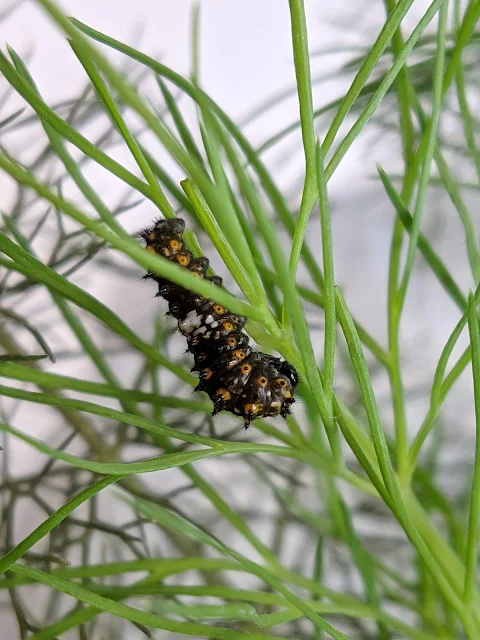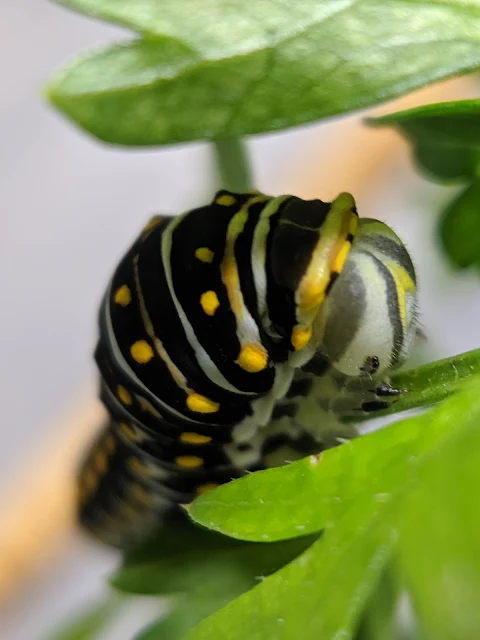Mid-August and my garden is a sandy strip of nothing-going-on. We've had weeks of 90s and oppressive humidity, and the stubs of golden alexander and parsley left by the Swallowtails are struggling to grow back. Yet I keep finding fresh eggs and caterpillars on them! Off to the nursery we went to find host plants. The herbs were wiped out so I headed for the clearance tables hoping to get lucky. There was nothing for Swallowtails but I found a table full of Tropical Milkweed (Asclepias curassavica) for $2.09. It was buy 2 get 1 but A.curassavica isn't native, so I picked a small 2 1/2" pot that, once home, totally surprised me with two Monarch butterfly eggs. I scrambled online to learn as much as I could as fast as I could. I basically had their four days as an egg to prepare.
The first thing I learned was that eggs laid after mid-August comprise the 5th generation of the year, the one that makes the incredible journey southward to overwintering grounds. Recently listed as endangered, I felt doubly pressured to ensure their survival.*
 |
| Here is a picture of a fresh Monarch butterflyegg. When mature, the egg doesn't turn
solid black like a swallowtail's. Only the tip does, unless it's been parasitized by Trichogramma wasps. |
Day 1 as caterpillars. I have to say, raising Monarchs is very different from raising Black Swallowtails. The method is the same (feed them their host plant, enable them to pupate, release a butterfly) but the experience is at a different pace and the details – the clues that tell you what to do next – are all different.
To begin, newly hatched Monarch caterpillars are impossibly small, and it's frustrating trying to see if anything is happening. Turns out it isn't much, and they are completely boring at first.
 |
| Do you see both Monarch caterpillars? |
Day 3 as caterpillars. They finally molted and wear black stripes, making them a little easier to find but I still needed a magnifying glass to find them. That's how I noticed little brown spots on the undersides of the leaves. Rust is a fungal plant disease that is host specific (won't jump to other plants) and doesn't harm the caterpillars. It is less of a problem for plants when moisture is managed properly. Next year I will look for a rust resistant variety but it would help if I knew what I had to start. I'm fairly certain the nursery mislabeled the plant I bought. Orange blossoms, fine hairs on the small leaves and stems, this narrow-leafed milkweed is most likely Butterfly Weed (A.tuberosa). Native to eastern and southwestern North America, I kind of wish I had bought three.
Swallowtails neatly eat entire leaves and stems but 2nd instar
Monarch caterpillars need to avoid releasing the sticky white sap
milkweed is known for. At their size it can glue their mouth parts shut.
The leaf above is a good example of their skeletonizing method of eating.
Day 5 as caterpillars. Still a second (of five) instar. A terrific reference to determine which instar your caterpillar is, is A Field Guide to Monarch Caterpillars (Danausplexippus) by Karen Oberhauser and Kristen Kuda.
Day 6 as caterpillars. With yellow stripes and tentacle nubs, they're finally starting to look like Monarch caterpillars.
 |
| Half a centimeter in the morning. |
 |
| Doubled in length in one day! |
 |
| Rather than skeletonizing, week old caterpillars eat more leaf but not the midrib. |
Day 8: Through the 3rd instar, two sprigs of butterfly weed has been enough for both caterpillars. This 4th instar is eating full leaves, including the midrib. Milkweed sap is full of the toxins that make Monarch caterpillars mildly poisonous to predators.
 |
| Older caterpillars will eat slices of cucumber, zucchini or butternut squash. You can also offer watermelon rind but feed them these alternatives only in a pinch.† |
Day 10:
 |
| At <3cm, not the "huge, finger thick" caterpillar we often hear about. |
 |
| Hanging in J-formation, opposite to Swallowtails which suspend themselves head up, feet down. |
 |
| Fifth instar Monarch caterpillar, ready to begin the final molt. |
 |
| Dorsal view of the final molt to become a monarch chrysalis. |
 |
| 1 day old chrysalis, wing veins already visible |
 |
Late night after 8 days as chrysalids, the famous orange and black wings clearly visible. |
 |
| Good morning 9-day old monarch chrysalis and brand new butterfly! |
Monarch wings are translucent. The stripes visible when the wings are folded are the same as those when their wings are spread open. This is different from swallowtails, whose wing spots in open and closed positions are different and you can only tell the sex when they're open.
 |
The wings being translucent surprised me. |





































